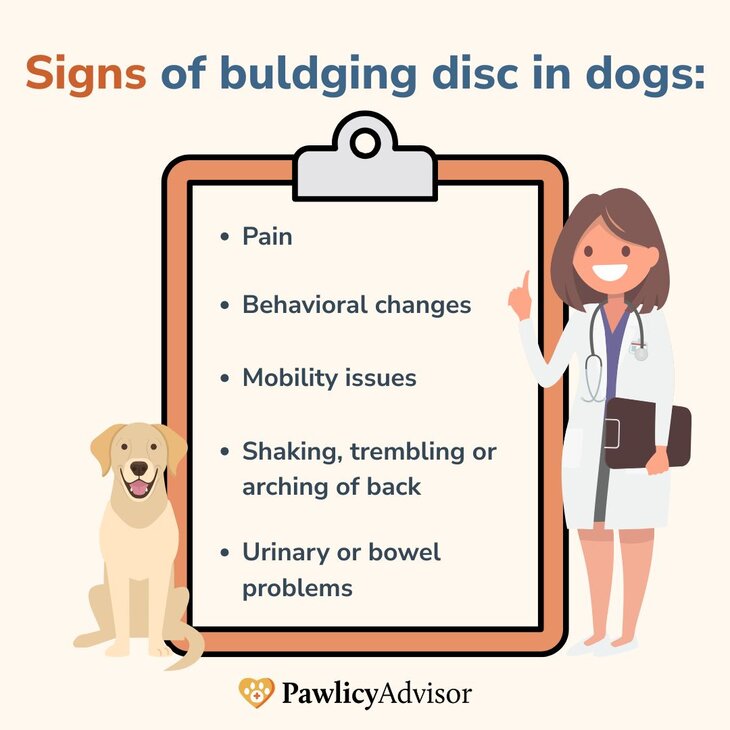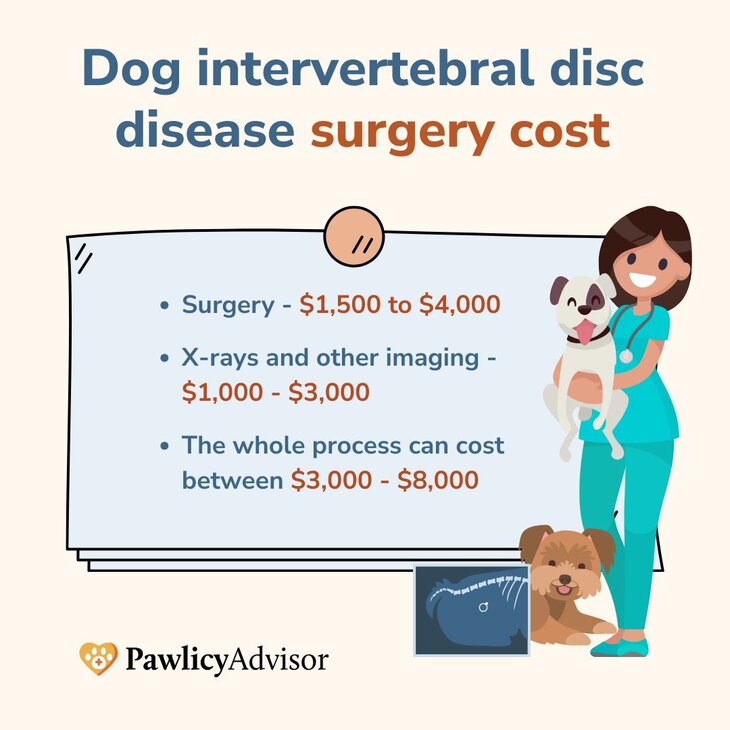How Much Does Dog Bulging Disc Surgery Cost?
Does your dog seem to be in pain or struggling to move comfortably? They could be suffering from a bulging disc, a common but serious spinal condition that requires immediate attention to prevent long-term complications.
Key Takeaways
- A bulging disc in dogs occurs when an intervertebral disc presses on the spinal cord, leading to pain, mobility issues, and potential paralysis.
- Symptoms include back pain, reluctance to move, dragging hind legs, trembling, and loss of bladder control—immediate veterinary attention is crucial.
- Surgery is often the best treatment for severe cases, costing between $3,000 and $8,000, including diagnostics and post-operative care.
- Pet insurance can help offset these costs—Pawlicy Advisor makes it easy to compare plans and find coverage for spinal conditions and emergencies.
Looking to save on vet bills? See if pet insurance is right for you.
Instant results. No spam. 1M+ pet parents served.
This guide will explore everything you need to know about canine bulging discs, from early warning signs to treatment steps, to surgery costs, and how pet insurance can help you and your furry friend.
✔️ Reviewed by multiple licensed veterinarians
✔️ Updated with the latest medical data
✔️ Compiled from veterinary research
- What is a bulging disc in dogs?
- What are the signs my dog may have a bulging disc?
- What happens if my dog’s bulging disc ruptures?
- How much does intervertebral disc disease surgery cost?
- How long is the recovery period for dogs who have undergone surgery for a bulging disc?
- Tips for picking the right insurance
What is a bulging disc in dogs?
A bulging disc occurs because of intervertebral disc disease (IVDD), a condition where the cushion-like discs between the vertebrae deteriorate or rupture.
When an intervertebral disc herniates, or “bulges” in a dog, it can press on the spinal cord, leading to pain or even paralysis.
There are two types of IVDD in dogs:
Hansen type I: More common in small dogs, this type of disc disease involves a sudden rupture of the disc, often caused by a quick, forceful action like jumping up or landing. While the disc weakens over time, the rupture itself occurs suddenly.
Typically affected breeds include:
- Dachshund
- Basset Hound
- Beagle
- French Bulldog
- Lhasa Apso
- Pekingese
- Pomeranian
- Shih Tzu
- Welsh Corgi
- Cocker Spaniel
- Cavalier King Charles Spaniel
- Doberman Pinscher, although this is a large breed
Hansen type II: This type of disc disease develops gradually as the disc slowly degenerates. No specific breeds are predisposed to this type of disc rupture. However, larger breeds such as Labradors and German Shepherds are more commonly affected.
In general, most disc problems happen along the back, while some occur along the neck.
What are the signs my dog may have a bulging disc?
Some of the most common symptoms of IVDD include:
- Pain: Particularly in the neck or back area
- Behavioral changes: Anxiety, loss of appetite, or avoiding stairs and furniture
- Mobility issues: Limping, dragging the hind legs, refusing to walk, or paralysis
- Physical signs: Shaking, trembling, or arching the back like a cat
- Urinary or bowel problems: Difficulty urinating, defecating, or loss of control
If you notice your pup experiencing these symptoms, especially sudden mobility problems, consult your vet immediately.

What happens if my dog’s bulging disc ruptures?
If a bulging disc ruptures, symptoms can become more severe, leading to sudden, intense pain, difficulty walking, paralysis, or loss of control over urination.
So, while the symptoms of a bulge and a rupture are similar, those of a rupture are often sudden and severe. Quick action is crucial.
Fortunately, a bulging disc is highly treatable. First, your vet will perform a physical exam, paying particular attention to your dog’s orthopedic and neurologic condition, to determine the severity.
If your dog’s symptoms are mild, your veterinarian will likely recommend rest and medications. This does not necessarily mean that your dog won’t need surgery later if their condition worsens.
If your dog is in pain and has neurological dysfunction, your veterinarian may recommend X-rays and advanced imaging to confirm the location of the ruptured disc and prepare for surgery.
Your vet will make the best recommendation based on their expertise and your dog’s specific needs.
They may recommend:
- Rest and medication: For mild cases, a combination of anti-inflammatory drugs and restricted activity can help manage pain and reduce inflammation.
- Surgery: The type of IVDD surgery your dog needs will depend on which part of their spine is affected. The most common procedures include:
- Dorsal hemilaminectomy: This procedure involves approaching the ruptured disc from the tissue over your dog’s back to remove disc material pressing on the spinal cord.
- Ventral slot procedure: This surgery involves approaching a ruptured disc in the neck area from the tissue under the neck.
Thankfully, dogs who have surgery shortly after disc rupture have as much as a
Without prompt surgery, the pressure on your dog’s spine can lead to permanent paralysis. If this happens, you can consider a mobility device, such as a cart, to help your dog move around.
After surgery, your dog will stay in the hospital for a few days for pain management, physical therapy, and bladder care (if they are unable to urinate on their own).

How much does intervertebral disc disease surgery cost?
The surgery itself ranges from $1,500 to $4,000, while X-rays and other imaging techniques may cost $1,000 to $3,000. The whole process could cost between $3,000 and $8,000.
Because of these high costs, we recommend investing in pet insurance, which can significantly reduce out-of-pocket costs.
By covering diagnostics, treatments, and surgeries (excluding pre-existing conditions), insurance provides financial relief when your pet needs it most.
Start exploring plans with Pawlicy Advisor to find the best fit for your dog's needs.
How long is the recovery period for dogs who have undergone surgery for a bulging disc?
While your dog’s specific recovery time will depend on the severity of their condition, vets typically recommend six to eight weeks of restricted activity. This includes keeping your dog confined to a small space like a crate. If your dog is not crate-trained, your vet may prescribe medicine to help them relax and rest. This step is especially important for energetic dogs who may reinjure themselves during recovery.
Your vet will also likely recommend physical rehabilitation to help your dog recover from the effects of disc disease and surgery.
Tips for picking the right insurance
Selecting the right pet insurance can feel overwhelming, but it doesn’t have to be.
Start by finding a plan that fits your budget while covering unexpected illnesses and emergencies, such as a bulging disc.
With the right coverage, you can be reimbursed for vet visits, exams, surgeries, treatments, and prescription medications—ensuring your dog gets the care they need without financial stress.
Pawlicy Advisor simplifies the process by comparing top insurance providers, helping you find a plan tailored to your pet's unique health needs and your financial situation.
Get started today for peace of mind for you and your furry friend.
Your pet's health is priceless — let's protect it together.
Do you want to find the best pet insurance?
Let's analyze your pet's breed, age, and location to find the right coverage and the best savings. Ready?
Analyze My PetAbout Pawlicy Advisor
The pet insurance marketplace endorsed by veterinarians, at Pawlicy Advisor we make buying the best pet insurance easier. By comparing personalized coverage and pricing differences we can save you a ton of money, up to 83% in some instances!
Instantly Compare Pet Insurance Plans
Guides
Determine If Pet Insurance Is Worth It
Comparison Charts
Find Your State
Dog Insurance
DVM, FFCP
Dr. Angela Beal has worked in private practice and taught veterinary technicians for 15 years. Angela is a veterinarian who loves using her writing to help pet owners provide the best possible care for their furry companions. Since 2020, she has worked full-time within the veterinary education writing and editing industry. Angela lives in Columbus, Ohio with her husband, two sons, and their spoiled Chihuahua mix, Yogi.
